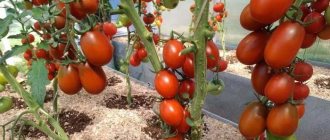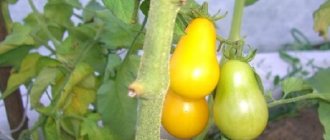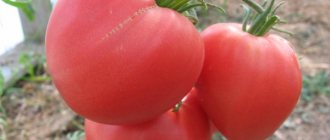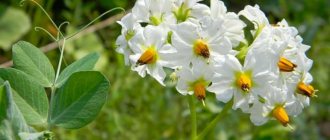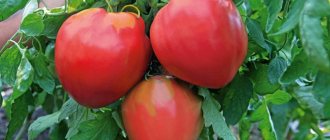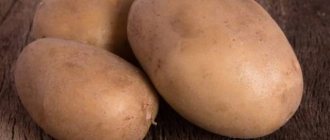Tomato “Heart of Ashgabat”: variety description
| Variety name | Heart of Ashgabat |
| general description | Mid-season semi-determinate variety |
| Originator | Folk selection variety |
| Ripening period | 100-110 days |
| Form | Heart-shaped |
| Color | Yellow |
| Average weight of tomatoes | 250-600 grams |
| Application | Fresh, for juices |
| Productivity of the variety | 30 kg per sq.m. |
| Features of cultivation | Standard agricultural technology |
| Disease resistance | Resistant to major diseases |
This is a very old variety of folk selection. It received state registration in 1972, and was first obtained in the late 60s in the Turkmen SSR. Since then it has had its loyal fans and new ones are constantly appearing.
This is a mid-early tomato variety; from the moment you plant the seedlings until the first fruits ripen, you need to wait 100-110 days. The type of bush is semi-determinate, standard. The plant is tall 110-140 cm. Recommended for growing in greenhouse shelters and unprotected soil.
It has very high resistance to fungal diseases of tomatoes.
With the right approach to business and creating good conditions, you can get up to 6.5-7 kg of excellent fruits from one plant. Recommended planting density is 4-5 bushes per square meter. m. It turns out about 30 kg, this is a very good indicator of productivity.
The main positive qualities of the “Heart of Ashgabat” variety are:
- disease resistance;
- very high yield;
- taste qualities.
Disadvantages include sensitivity to temperature and light conditions, as well as demands on fertilizing.
Among the features of the variety are the high content of vitamins in its fruits and high taste. Productivity and resistance to fungal diseases are also undoubtedly noted.
You can compare the yield of this variety with others in the table below:
| Variety name | Productivity |
| Heart of Ashgabat | up to 30 kg per square meter |
| Lazy | 15 kg per square meter |
| Bobcat | 4-6 kg per square meter |
| Summer resident | 4 kg per bush |
| Banana red | 3 kg per bush |
| Russian size | 7-8 kg per square meter |
| Nastenka | 10-12 kg per square meter |
| Broody | 10-11 kg per square meter |
| King of Kings | 5 kg per bush |
| Fat Jack | 5-6 kg per bush |
| Bella Rosa | 5-7 kg per square meter |
On our website you will find a lot of useful information about growing tomatoes. Read all about indeterminate and determinate varieties. And also about the intricacies of caring for early ripening varieties and varieties characterized by high productivity and disease resistance.
Advantages and disadvantages compared to other similar varieties
The fact that many gardeners have been interested in this variety for half a century, and this interest has only been growing in recent years, testifies to the great potential that breeders have built into it. Seeds in bags are sold in 7-10 pieces and do not cost a penny at all. The variety has the following advantages:
- good yield;
- excellent taste of fruits;
- long-term preservation and good transportability;
- resistance to major diseases;
- beautiful appearance.
As relative disadvantages, they note the need to form a bush and the increased heat-loving nature of the variety, which does not allow it to be grown in the middle zone and in the north without shelter.
The number of tomato varieties is currently huge, many of them bearing yellow tomatoes, as well as those with heart-shaped fruits. But there were not many varieties that combine these two characteristics at the same time. Thus, tomatoes Bull's heart orange and Bull's heart amber have similar characteristics, and Bull's heart golden is characterized by excellent fruit taste and high yield, but is late-ripening. The Golden Heart tomato is early ripening, but its fruits weigh only 100 g, so they are used in whole-fruit canning.
The orange Honey Heart tomato also has rather small fruits, but the taste is characterized as excellent. The Orange Heart variety is also popular, bearing small fruits of excellent taste that retain their qualities during long-term storage. Thus, recently many varieties have been created that are similar to the Heart of Ashgabat and are its worthy competitors.
Characteristics
- Fruits that have reached varietal maturity are bright yellow in color and heart-shaped.
- The tomatoes are medium in size, closer to large, weighing 250-350 grams. The fruits of the first harvest can reach 400-600 grams.
- Number of cameras 6-7.
- The dry matter content does not exceed 6%.
- The collected fruits can be stored for a long time and tolerate transportation well.
You can compare the weight of fruits with other varieties in the table below:
| Variety name | Fruit weight |
| Heart of Ashgabat | 250-600 grams |
| Ilya Muromets | 250-350 grams |
| Morozko | 50-200 grams |
| Wonder of the world | 70-100 grams |
| Red cheeks | 100g |
| Inseparable hearts | 600-800 grams |
| Red Dome | 150-200 grams |
| Black Heart of Brad | up to 1000 grams |
| Siberian early ripening | 60-110 grams |
| Biyskaya Rose | 500-800 grams |
| Sugar cream | 20-25 grams |
These tomatoes are very good fresh. The juices are very tasty and healthy, due to their high content of vitamins, they are recommended for dietary nutrition. You can make preserves, but only from the smallest fruits. Larger fruits can be used for barrel pickling.
Preparation of planting material and propagation
Since the variety is mid-season, it must be cultivated using seedlings. Due to this, he will be able to fully ripen before the arrival of the first cold weather. Strong and healthy seedlings are the key to productive tomatoes. To obtain such seedlings, it is necessary to take a more responsible approach to all stages of its cultivation.
Initially, it is necessary to prepare the seed material, since the plant’s resistance to infections and the harmful effects of the environment will depend on it.
To perform the procedure correctly, you must adhere to the following steps:
- Initially, select seeds that have managed to germinate. For these purposes, immerse the seeds in a warm salty liquid prepared from 250 ml of water and 11 g of salt. Workpieces that have fallen to the base of the container are suitable for sowing.
- Since infections may remain on the seed, the seeds should be disinfected by leaving them for 20 minutes. into a weak solution of hydrogen peroxide or manganese.
- For additional disinfection, immerse the planting material for 12 hours in a soda solution prepared from 250 ml of liquid and 14 g of soda, or aloe juice, which was diluted with water in a 1:1 ratio.
- Upon completion of processing, immerse the seeds in honey water, sodium humate or Epin to improve the seeds' resistance to cold and speed up their germination.
It is permissible to pre-germinate the seeds. For these purposes, the blanks will need to be placed on napkins that cover the base of the deep container. The napkins will first need to be moistened with a growth stimulator. The top of the planting material must be covered with several layers of moistened gauze. Before germination, the workpiece must be stored in a warm room, periodically moistening the gauze with warm liquid.
If you grow seedlings in a warm greenhouse, it is permissible to use a substrate in which adult shrubs will grow in the future. The soil mixture will first need to be disinfected with hot copper sulfate.
For cultivation in apartment conditions, you will need to prepare a special substrate. For these purposes, it is necessary to take soil from the area where the seedlings will grow. It should be combined with peat or humus in the same volume. You will need to add 1/2 part of the coconut substrate, sawdust or sand to the substrate. A bucket of this mixture should be supplemented with 200 g of ash and 23 g of superphosphate.
To obtain seedlings, it is permissible to use a store-bought substrate. It must be universal or designed for growing peppers and tomatoes. Any soil mixture must be disinfected by calcining it in the oven, pouring hot copper sulfate or a concentrated manganese solution.
Initially, a common box is used for sowing. Available materials or special seedling containers are suitable. When the seedlings grow, they will need to be distributed into separate containers, the volume of which will be 500 ml. For these purposes, you can use peat pots, plastic cups or cut-off 2-liter bottles. Before sowing, containers must be disinfected by immersing them in a dark manganese solution for 30 minutes.
Seeds
Planting material must be sown 60 days before transplanting seedlings into the soil layer. Sowing often takes place in March.
Step-by-step instructions for sowing:
- Fill containers for seedlings with substrate and irrigate with warm liquid. Make ditches 1 cm deep in the soil mixture at a distance of 3 cm from each other. Lower the planting material, maintaining an interval of 2 cm.
- Sprinkle the seeds with substrate. Cover the boxes with film and place in a warm room.
- Remove the film cover for 20 minutes every day. to prevent moisture stagnation.
Seedlings do not require difficult cultivation, but the following conditions must be strictly adhered to:
- After germination of the planting material, it is necessary to remove the film by moving the containers to the windowsill. If the seedlings do not have enough natural light, it is recommended to use fluorescent lamps.
- It is necessary to irrigate the seedlings according to the degree of drying of the substrate. Water at room temperature is suitable for the procedure, which should not come into contact with the leaves.
- The seedlings should not be in a draft, otherwise the fragile seedlings will die.
- With the appearance of 2 true leaves, the seedlings must be divided into individual containers, the base of which should be filled with a drainage layer. For 10 days from the moment of transplantation, the seedlings do not need to be irrigated or fertilized.
- 2 weeks after separation you will need to apply the first fertilizer. With an interval of 14 days it is necessary to feed the soil mixture 2 times. Complex formulations containing phosphorus are suitable.
Before planting in a permanent habitat, seedlings must be hardened off. 14 days before picking, the seedlings must be taken outside, gradually increasing their time spent in the fresh air.
Photo
You can see photos of the “Heart of Ashgabat” tomato variety below:
Care
Caring for tomato seedlings is quite simple. It will be necessary to carry out timely irrigation with fertilizing and formation.
Spraying and watering
Irrigation should be carried out 2 or 3 times a week. One bush will require at least 2 liters of liquid. The soil cover must be moistened in the morning or at sunset so that moisture does not fall on the foliage and stems. When stepsoning, the procedure does not need to be carried out. After each irrigation, it is necessary to loosen the substrate, removing weeds.
Top dressing
Fertilizing is required to be applied 4 times throughout the season, combining organic fertilizers with complex mineral compounds. Chicken manure with humus and silage is suitable as organic matter.
Trimming
Seedlings must be grown in 2 or 3 stems. The fewer stems left, the larger the tomatoes will be. However, their number will be low.
During formation, it is necessary to get rid of withered foliage and greenery, which are located below the first flower cluster. You need to pick no more than 3 leaves at a time.
Tying up
Plants need to be tied up. It is necessary to fix the main trunk and brushes with heavy tomatoes to the support. A synthetic thread that is not subject to rotting is suitable for gartering.
Optimal conditions
Tomato Heart of Ashgabat (reviews from gardeners will explain the features of cultivating the plant outdoors) can develop cracks in the presence of prolonged rainfall. However, unfavorable weather conditions do not affect the formation of ovaries. Despite the fact that the crop is not afraid of cold weather, it does not have good frost resistance.
Features of cultivation
In unprotected soil, “Heart of Ashgabat” is best grown in southern regions, such as Crimea, Rostov or Astrakhan region.
Important: In the middle zone it is necessary to cover with film to avoid loss of yield. In more northern regions, cultivation of this species is possible only in heated greenhouses.
The trunk of the bush must be tied up, and the branches must be strengthened with supports, this will save them from breaking off under the weight of heavy fruits. The bush is formed into two or three stems, most often two. At all stages of growth, it responds well to complex feeding.
Landing algorithm
Tomato Heart of Ashgabat (reviews from gardeners will tell you how to plant seedlings in the soil layer) must be planted in open areas when the soil cover is warmed to a depth of 15 cm. In greenhouses, replanting can be done 14 days earlier.
The timing of planting seedlings in the soil layer will depend on the region:
- end of April or beginning of May - for the southern regions;
- mid or late May – for central regions;
- early June – for the northern regions.
Before transplanting, the seedlings must be fertilized and irrigated so that they adapt more quickly to the new area.
Landing algorithm:
- Dig holes in staggered rows. Place 5 seedlings per 1 m2.
- Place dry granular compounds or ash into the pits.
- Initially remove the seedlings from the containers, carefully placing them in holes and deepening them to the lower foliage. Sprinkle the holes with substrate and compact them.
- Pour 1 liter of warm liquid under each bush. After 14 days, perform a second irrigation.
It is permissible to plant tomato seedlings using the “lazy” method, spending a little time on care throughout the entire growing season.
Step-by-step planting instructions:
- Dig planting holes 30 cm deep and 50 cm wide. The distance between the holes should reach 120 cm. Place a tall wooden stake in the middle of the hole.
- Fill the base of each pit with a bucket of rotted manure with humus and sand, alternating layers. Fill the remaining space with garden soil. Add 500 g of ash and 85 g of nitrophoska into each hole. Mix the ingredients well.
- Place up to 5 seedlings, the age of which has reached 60 days, into each hole. Remove the lower leaves from the bushes. Secure the seedlings to one injection, which is located in the middle of the hole.
- Pour 1 liter of liquid into each hole. Mulch the depressions with burlap, fallen leaves, straw or hay.
With such planting, irrigation must be carried out twice a week, and there is no need to loosen the beds, since worms will appear in the fertile soil mixture, which will independently perform loosening. During the summer season, only 1 fertilizing will be required in the form of a solution of chicken manure.
To do this, you will need to dilute 1 part of the raw material with 10 parts of water. Shrubs must be treated with boric acid three times per season. At the same time, up to 40 kg of crop can be collected from each depression.
Diseases and pests
This variety rarely suffers from diseases caused by the fungus. The plant can get sick if it is not cared for properly.
To avoid such problems when growing “Heart of Ashgabat”, you need to regularly ventilate the room where your tomatoes are growing and follow the watering and lighting regime. Unprotected soil must be loosened; this will serve as additional prevention against pests.
Of the harmful insects, it is often damaged by melon aphids and thrips; the drug “Zubr” is successfully used against them.
In open ground, mole crickets and slugs can cause significant damage to the plant. They are combated by loosening the soil, and also using dry mustard or hot ground pepper diluted in water, watering the soil around the bushes with a 10 liter spoon, the pest then disappears.
Of the pests that are most capable of causing harm in greenhouses, these are, again, melon aphids and thrips; the drug “Bison” is also used against them.
Features of cultivating the variety in open and protected ground
Before planting tomatoes in a greenhouse, be sure to treat the walls with copper sulfate. The soil in the beds is being replaced. New soil is also disinfected.
Ventilation is another important step. This procedure helps maintain optimal humidity in the room, reducing the likelihood of plant infection.
In a greenhouse, plants are helped to pollinate. The first option is to periodically shake the bushes during flowering. The second way is to install a fan in the room.
In a greenhouse, tomatoes are watered once a week, and in open ground - 2-3 times.
At night, tomatoes planted in open ground are covered with film for two weeks. This will protect them from night frosts.
Video
We invite you to watch a video review of the tomato variety “Heart of Ashgabat”:
| Mid-early | Super early | Mid-season |
| Ivanovich | Moscow stars | Pink Elephant |
| Timofey | Debut | Raspberry Onslaught |
| Black truffle | Leopold | Orange |
| Rosaliza | President 2 | Bull forehead |
| Sugar giant | Pickling miracle | Strawberry dessert |
| Orange giant | Pink Impression | Snow fairy tale |
| Stopudov | Alpha | Yellow ball |
Features of agricultural technology and reviews from vegetable growers
The rules for growing the Heart of Ashgabat are not complicated:
- seeds for seedlings are sown in the 1st decade of March;
- transplanted to a permanent place around mid-May;
- planting density – 4-5 plants per 1 sq. m.;
- formation of 2-3 stems.
Of the numerous reviews left by gardeners on thematic forums, there were no outright negative ones. The following were selected from the most interesting opinions about tomato:
- Evgenia from Saratov writes: “My bushes did not stretch more than 1.2 m, there was not much foliage, they led into 3 trunks. Tomato was affected by late blight, but weakly. I like the shape and color: bright orange, heart-shaped, without green shoulders. They taste very sweet. My husband doesn’t like them, he thinks that tomatoes should have a pronounced sourness.”
- Sergey from Rostov region Fr.
- Nadezhda from Krasnodar shares: “For some reason, my seedlings were frail, I was already worried that nothing would grow from them. But the tomato bushes grew stronger and became spreading. The taste especially captivated me. Other yellow-fruited tomatoes that I grew before this variety cannot be compared. Now this is my favorite."
If the description and opinions of fellow gardeners were able to interest you, then it is possible that a sunny tomato variety of ancient selection will soon appear in your garden bed.
